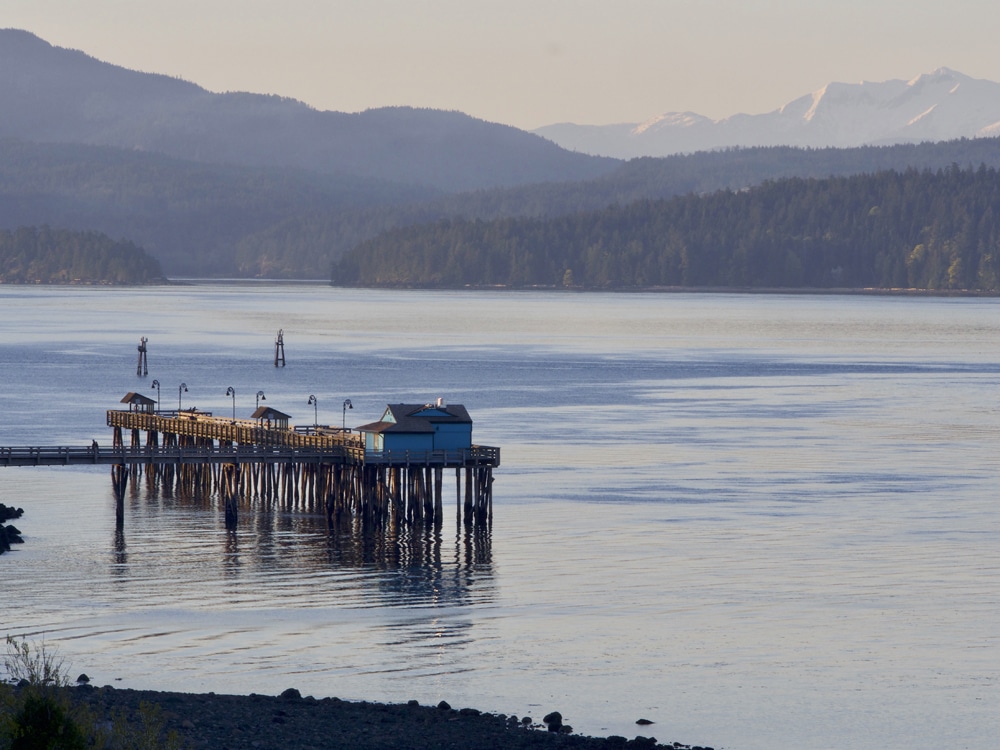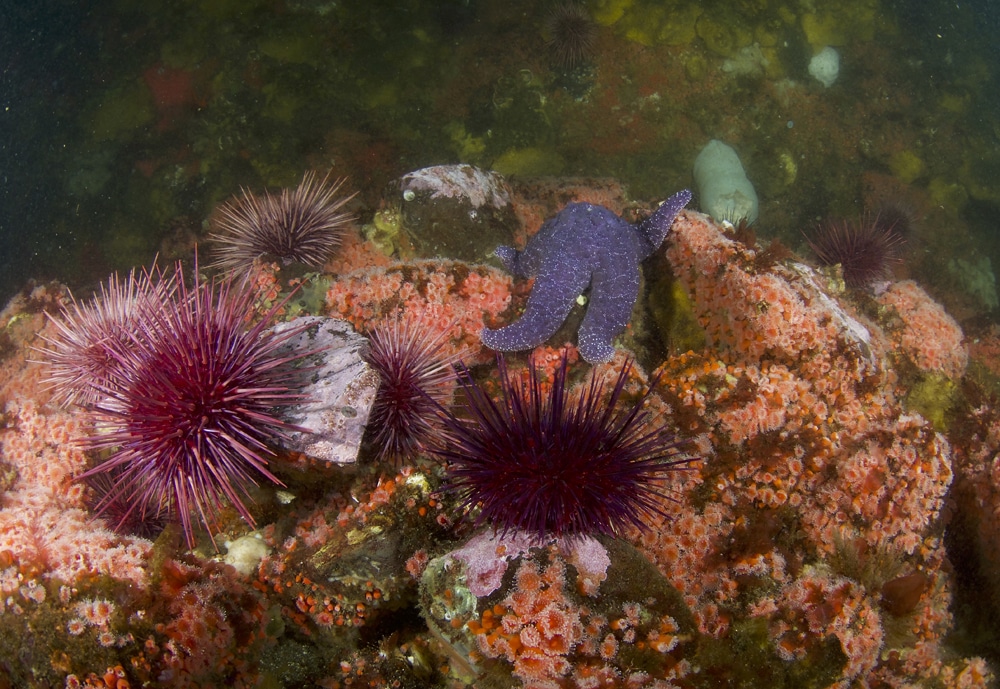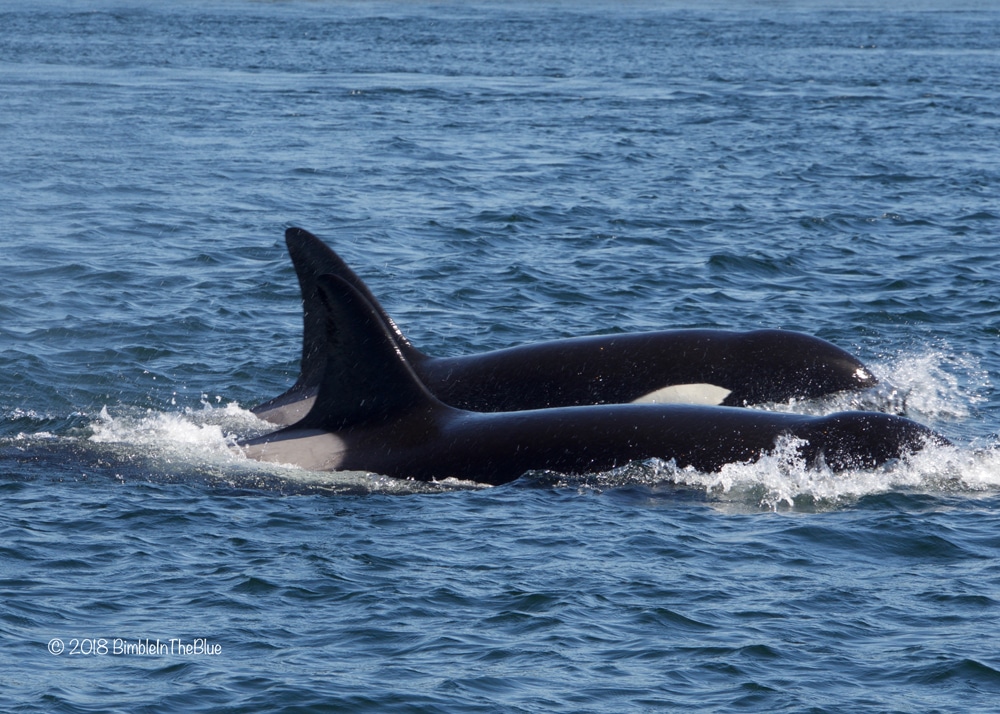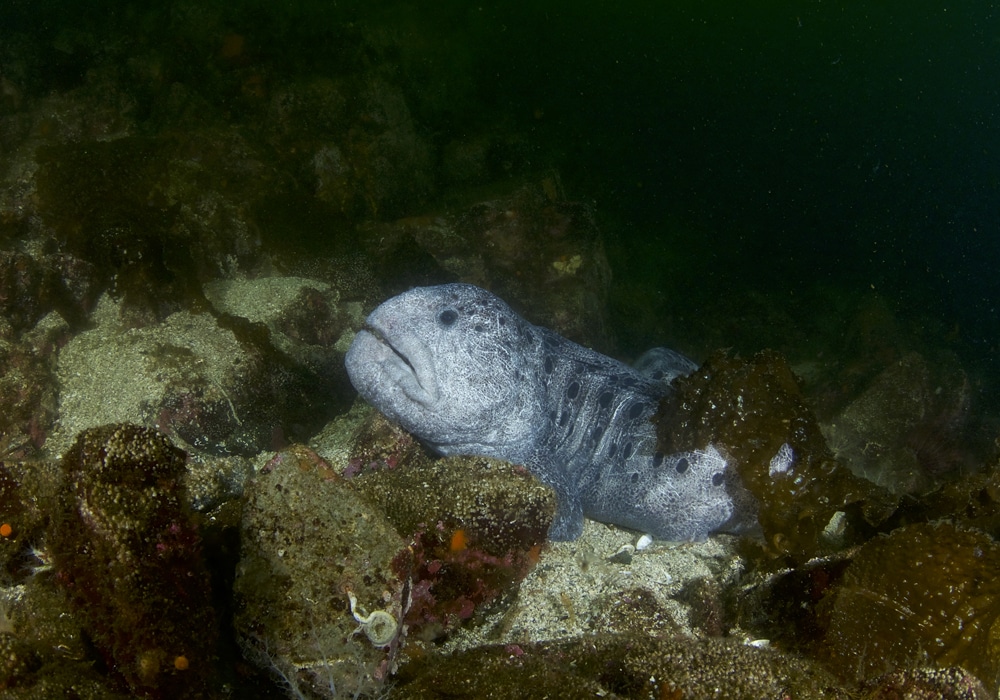News
Diving Discovery Passage
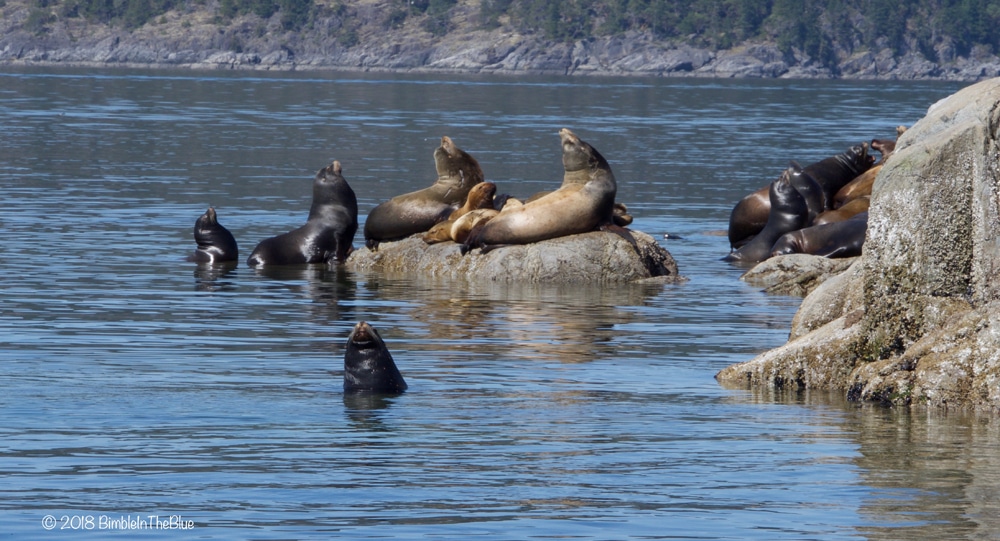
If you like cold water diving, then it doesn’t get much better than diving off Vancouver Island in B.C, Canada. Vancouver Island is a place packed full of incredible natural beauty and a wealth of wildlife; snow-topped mountain peaks give way to forests and beaches with bald eagles soaring above them, the blue surrounding waters home to whales, orcas, seals and Steller sea lions. It’s really quite an incredible place!
The waters between Vancouver Island and the mainland is packed full of smaller islets, creating numerous channels, where some of the world’s strongest tidal currents ebb and flow. Since currents are vital to all marine organisms, through the transport of nutrients and oxygen and the dispersal of eggs, spores and larvae, it is unsurprising that some of the richest marine life is found where there are both nutrients and strong current. The dive sites around Vancouver Island simply teem with life!
Good dive planning is important; the currents round here take no prisoners. It is essential to have a good local skipper who will put you in the right place at the right time and pick you up when needed. Places like Seymour Rapids are so named for a reason and being there at the max flow is not a sensible course of action if you wish to continue living a long and healthy life. Even near slack, on neap tides you can have adrenalin drift dives in some places, so go careful; get the local knowledge and stick to the advice.
On our trip we decided to have Campbell River as our base; the town has lots of accommodation options, good restaurants and even its own brewery! We had also heard good things about the nearby dive sites and wildlife watching tours. Our trip was a bit last minute (Shall we go to Canada? Sounds good. Ok, let’s go!) so we arrived with a tentative booking and found the hotel to be fantastic. We had a huge 1 bed apartment overlooking the water, for next to nothing. Sadly the diving booking was less successful, the company we were going to go with didn’t get back to us and the local dive centre Pacific ProDive, though very friendly and helpful, had no boats going out weekdays. They did however rent us tanks and tell us about several shore dive options. Not to be deterred from getting on the water, we decided to take the opportunity to go on a wildlife watching trip. Given this area is famed for its cetaceans, pinnipeds and birdlife, it was not one we were going to miss!
We had already chatted online with a company that we liked the sound of: Aboriginal Journeys, an excellent company owned by an elder of the We-Wai-Kai First Nation. Our local guide Garry had 40 years of experience in the waters around Vancouver Island and a huge passion and respect for the wildlife, his enthusiasm was wonderful. We had a very enjoyable half day wildlife watching trip, delicious lunch included. We were given lots of information on animal behaviour, best viewing seasons for various local species and the threats facing the species we observed.
It was a great trip and we were able to see dolphins, porpoise, fur seals, eagles fishing and the huge Steller sea lions. The expert guidance was fantastic, however the orcas were not out to play in our area that day. We arranged to do a second trip anytime on the next few days if orcas were sighted, as long as we were not diving. Garry was also extremely helpful in recommending a local diver and boat captain who would take us out diving!
The next day we found ourselves on Earl’s boat. Earl has run Abyssal Diving for 20 years and is an expert on the local conditions. He had agreed to take the boat out with just Mike and I for a very reasonable rate and so we had the boat to ourselves! Having not had us on the boat before, and us being new to the area, Earl chose an easy site for the first dive, “Middle of the Road”. Located on the leeward side of Quadra Island, this dive often features less current than some other sites. We kitted up with building excitement, watching the surface for signs of the calmer back eddy we were planning to jump into. Our plan was to drop down onto the shallow rocky area, sheltered from the worst of the current, explore for 15 minutes or so, allowing the tide to slacken and after 1/3rd of the dive, move to the wall and drift along until ready to surface.
Starting in the shallows we admired the colourful cup corals, big sunflower stars and purple sea urchins nestled in between the bull kelp. There were nudibranchs the size of my hiking boots! Sea lemons; they’re massive and all over the place! As we swam left, we reached a wall that drops to around 17 meters or so, covered in strawberry anemones and yellow sponges. Drifting along we occasionally looked out into the green/blue incase of any passing mega fauna, but for the most part we were captivated by the masses of stunning macro life that covered the wall. All too soon it was time to return to the surface where Earl is waiting to collect us. If this was the kind of diving here, 3 days won’t be enough!
After a surface interval chatting about the local area and enjoying warming up in the sunny weather, we headed to our next dive site “Row or Be Damned”, so named as sailors of old would have to row swiftly to navigate this area, close to a steep cliff on Quadra Island. This site can get a bit more lively and having got our bearings somewhat on the first dive, we were ready to drift the boulders and cracks looking for wolf eels. An incredible carpet of sponges, sea pens and anemones awaited us and we spent a very happy dive exploring the cracks and crevices. There were numerous Irish lords, rockfish and lingcod, but sadly but sadly no wolf eels.
We returned from the 2nd dive trip in very high spirits and bumped into Garry on the dock, who had just had a successful trip to see a humpback whale reported in the area. After rinsing out kit and a quick spruce up back at the hotel, we ventured into town to check out the local brewery tap room “Beach Fire Brewing and Nosh House”. Both the food and beer options were great and we can highly recommend a sojourn here if you are in the area!
Our second dive day saw us skippered by Earl’s uncle Dave and diving “Whiskey Point” and “Copper Cliffs”. “Whiskey Point” is a drift dive round huge boulders and along a wall with cracks, with resident wolf eels. We had a fair drift (tame for this area), around 4 knots, swirling and picking up in parts, which was good fun. The scenery was as diverting as ever with massive anemones, nudis and sponges everywhere, rockfish and schools of perch. Though once again we missed the wolf eels, Mike did have a flying visit by a seal, that checked out the back of his head before zooming off into the green depths.
“Copper Cliffs” is an exciting site, as the boat pulled alongside shear cliffs that rose 30m above us and, we were told, continue 30m down to the boulder field in the passage. The cliffs have a pretty blue/green hue from the copper veins running through the rock and below the surface you can already see plumose anemones half a meter long. This site was stunning, with all the usual suspects, plus cloud sponges and lots of sculpin. We explored the wall and boulder field until the current started to make itself felt and before it became an effort we returned to the wall and spend a very happy safety stop admiring anemones.
On surfacing we heard that Dave had spotted a group of orca that apparently swam past us when we were diving, and we spend an eager 10 minutes scanning the water for signs of a blow or dorsal fin, sadly to no avail. Back at the dock we once again ran into Garry, who had also heard reports of the Orca and offered to take us out again for the afternoon. This time luck was with us and we had a whole 2 hours of orca watching action, and my goodness, they are stunning creatures!
I had been wanting to see orcas for a very long time and have been on many trips in other countries to try and see them, with no success, to say I was excited would be a huge understatement.
Our last day in Campbell River was spent hiking to the nearby overlook at Ripple Rock, where you can see whirlpools formed by the rushing tidal currents in Seymour Narrows. This area was once considered the most dangerous stretch of water on the inside passage of Vancouver island, due to the craggy ripple rocks lying below the surface. When the tide was running the area would turn into a maelstrom, hiding the location of the rocks and creating swirling currents, many boats were lost and so in 1953 the BC government decided to blast Ripple Rocks apart in the largest peacetime non-nuclear explosion in the world. Now a more navigable channel the water still gets dicey and it was a great sunny day activity to hike through the forest and watch the waters churn from the viewpoint. The number of bald eagle’s in the area is also incredible, we must have seen more than 30 in just a few days.
Having had such a wonderful time in Campbell River, it was time to head south back towards the ferry. Before leaving we popped into Pacific ProDive, to thank them for their advice earlier in the week and return the tanks. they informed us that their sister shop, in Courtenay, had a dive going out the next day to the “S.S. Capilano”, a union steamship which sank in 1915. Since it was on our way south, we booked on for this unexpected extra dive day.
The harbour at Courtenay is much bigger than Campbell River, though the boat was easy to locate and the staff and divers friendly. It was a bit of a shock to have a full boat and 45min journey after our 2 days off private charter at dive site 5 minutes away. On the trip out we learned that the S.S. Capilano was a Union Steamship that sank in the Straight of Georgia in 1915 and sits upright in 40m. Most of the boat were tec and rebreather divers given the depth of the wreck and we knew we would be having a short dive, as the top of the wreck starts at 30m.
Once on the line we descended into a thick green murk that had us struggling to see our hands in front of us, at 6m we finally cleared the planktonic layer and emerged into darkness, as the surface light was all but obscured. Taking a moment to turn on our torches, we checked with one another and continued our descent. The visibility below the surface layer was excellent over 20m, at 10m above the wreck we got out first glimpse, the whole outline of the ship below could be seen, an eerie white glow, caused by our lights illuminating the plumose anemones that cover the hull. The lights of our fellow divers illuminated the wreck quite well and so hovering above the main structure gave a great sense of the wreck. She is covered with life and massive lingcod lurk in the cargo hold. We circumnavigate the wreck and then regretfully return to the shot line, our no deco time is all too short for this stunning wreck, but we appreciate this unexpected bonus dive as we head back to the surface.
For the surface interval we head to a nearby island to observe seals and sea lions hauled out on the rocks and enjoy a warming cup of coffee. The next dive is on the reef alongside the island and though the visibility was poor we finally succeeded in seeing a huge wolf eel, lounging outside his hole and completely at lease with us hovering beside him! We also saw tonnes of nudibranchs and a grunt sculpin, a first for me! Sadly I didn’t get a photo of the grunt sculpin, but what a wonderfully weird looking fish, if you haven’t seen one, google it, they’re great!
Sadly that was the last of our Vancouver Island adventures and we headed back to the airport, but we will definitely be back.
For anyone considering a trip to this part of the world, the diving is absolutely world-class, but, (and this is not something you will often hear me say), a visit here would also be entirely worth the travel time and expense even if you didn’t go diving! We were very happy staying in Campbell River, the diving was fantastic, and also offered a huge range of wildlife watching opportunities, including bear watching trips in season. Nearby hiking trails, shopping and a good choice of restaurants and craft beer bars to enjoy in the evenings made this an excellent base. If you want a holiday with a mix of activities or are travelling with any non-divers, I really cannot recommend Vancouver Island highly enough.
News
Book Review: Fire on Monroe Bravo by Fred Lockwood

Fire on Monroe Bravo is the latest book in the Jack Collier series by Fred Lockwood. Our story begins with our lead characters, Jack and Sandro, owners of Marine Salvage & Investigation Company, arriving on the Monroe Bravo Oil & Gas Platform in the North Sea. Having secured a contract for their vessel the MV Stavanger to act as support ship to the platform for TransGlobal Oil, our protagonists are on a celebratory visit.
However almost as soon as they arrive a series of explosions rock the platform, causing huge damage, loss of life and the very real danger of a massive human, ecological and financial disaster.

As the danger mounts for both our heroes and the surviving workers, Jack and Sandro will have to escape the inferno, all while trying to save the platform and the men still trapped unable to help themselves.
The disaster sets the scene for the unfolding story lines following the fate of the platform and our main characters, the police investigation into a suspected terrorist act and the actions of TransGlobal Oil as they attempt to navigate the pubic outcry and financial repercussions.
In his eighth book, Fire on Monroe Bravo, Fred Lockwood delivers an explosive thriller, with plenty of above and in-water drama, and our heroes fighting for survival, what more can you ask for?
We thoroughly recommend this read and look forward to the next in the series. For more information about his book series, you can check out the reviews of his previous books here on Scubaverse.
- Title: Fire On Monroe Bravo
- Author: Fred Lockwood
- ISBN: 979-8325324536
Available in a paperback version and for Kindle from Amazon and book stores.
Blogs
Alonissos: The complete diving destination (Part 1)

In June we were incredibly fortunate to be invited to dive in Alonissos, a small Greek Island in the Sporades island chain located in the North Aegean Sea. While I have long been a big fan of the Greek Islands as a great holiday destination, I had not had the opportunity to do any diving on previous visits and Mike and I were extremely excited to see what Alonissos had to offer both above and below the surface!

The Sporades are easily accessible via the airport in Skiathos (the first island in the chain), which is served by Jet2 flights from all major UK airports from May through October. Numerous ferries and charter boats make island hopping from Skiathos Town a breeze. After an hour boat ride, the picturesque port of Patitiri was a wonderful introduction to Alonissos, where we were met by our gracious hosts Kostas of Albedo Travel and Dias of Alonissos Triton Dive Center. Mike and I were delighted to be staying at the Paradise Hotel, aptly named for its stunning views over the sea and great location for walking to the waterfront.

Alonissos is beautifully situated in the National Marine Park of Alonissos and the Northern Sporades, the largest marine protected area in Europe. The surrounding seas offer fabulous marine life, including incredibly rare species such as the Mediterranean monk seal. They boast deep walls covered in gorgonians and sponges, stunning topography with caverns, swimthroughs and pinnacles, and the first accessible ancient shipwreck from 500BC!

In locations where historical sites have been reported, the waters are largely restricted, but with collaboration between government, underwater archeologists and dive centres, incredible underwater museums are being created for a truly unique diving experience. Alonissos is home to the first of these, the Ancient Shipwreck of Peristera Accessible Underwater Archeological Site. The chance to dive into history (along with reports of healthy reef life and amazing underwater topography) meant Mike and I were keen to get in the water.

Our introduction to the diving around Alonissos was at the Agios Georgios Pinnacles, in the channel between Alonissos and Skopelos. This fantastic site was named “The Chimney,’ and proved to have a huge amount to see. We got to a decent depth here (over 25m), and marvelled at a colourful reef wall with a wonderful swim through whose rocky walls were absolutely covered with life. As well as brilliant topography there was no shortage of macro life here. We saw numerous nudibranchs, five different species in total. The second dive at Mourtias reef nearby was a shallower dive along a nice wall with lots of crevices. Several moray eels and grouper called this site home. We enjoyed looking in the crevices for lobster and smaller benthic life, such as cup corals and tunicates.

Our itinerary allowed us two dives a day with afternoons left to explore the island with our hire car and evenings to enjoy the famous Greek hospitality. This proved to be a lovely mix of in-water and land based diversions.

The next days diving to the Gorgonian Gardens and Triton’s Cave was to be even better! These two stunning sites are nothing short of fabulous. The Gorgonian Gardens was a deep wall near to the Agios Georgios islands. The ever-present currents in this deep channel meant that the sea life was amazing … the namesake Gorgonian sea fans dotted the wall at a depth of 30 to 50 meters, getting ever larger the deeper we went. Above 30m was by no means less beautiful, with sponges, corals, scorpionfish, moray eels and some rare and colourful nudibranchs.

The second shallower dive of the day was to Triton’s Cave or the Cavern of Skopelos, on the east side of that island. The spectacular rock formations had wild striations both above and below the water making a truly epic topography. The cavern entrance was at 14m, and big enough for a buddy pair, winding up to 6m and passing two beautiful windows out into the blue. Emerging from the cavern, the light at the shallower depths and the incredible rock formations made for a fantastic gentle swimming safety stop and we all surfaced by the boat with massive grins.

Check out our next blog :Alonissos: The complete diving destination (Part 2)” to hear about our amazing dive on the 2500 year old Peristera Wreck!
Thanks to:
Alonissos Triton Dive Center https://bestdivingingreece.com/
Albedo Travel https://alonissosholidays.com/activities/
Paradise Hotel https://paradise-hotel.gr/
Alonissos Municipality https://alonissos.gr/en/
-

 Blogs2 months ago
Blogs2 months agoDiving With… Nico, Ocean Earth Travels, Indonesia
-

 News1 month ago
News1 month agoMurex Bangka Announce New Oceanfront Cottages & Beachfront Dining
-

 Blogs2 months ago
Blogs2 months agoA new idea in freediving from RAID
-

 Marine Life & Conservation1 month ago
Marine Life & Conservation1 month agoIceland issue millionaire whale hunter a licence to murder 128 vulnerable fin whales
-

 Marine Life & Conservation2 months ago
Marine Life & Conservation2 months agoThe Shark Trust Great Shark Snapshot is back
-

 News3 months ago
News3 months agoCharting New Waters; NovoScuba Goes Global with the Launch of their Revolutionary Dive Training Agency!
-

 Gear News1 month ago
Gear News1 month agoNew Suunto Ocean – a dive computer and GPS sports watch in one for adventures below and above the surface
-

 Marine Life & Conservation Blogs2 months ago
Marine Life & Conservation Blogs2 months agoBook Review: Plankton


